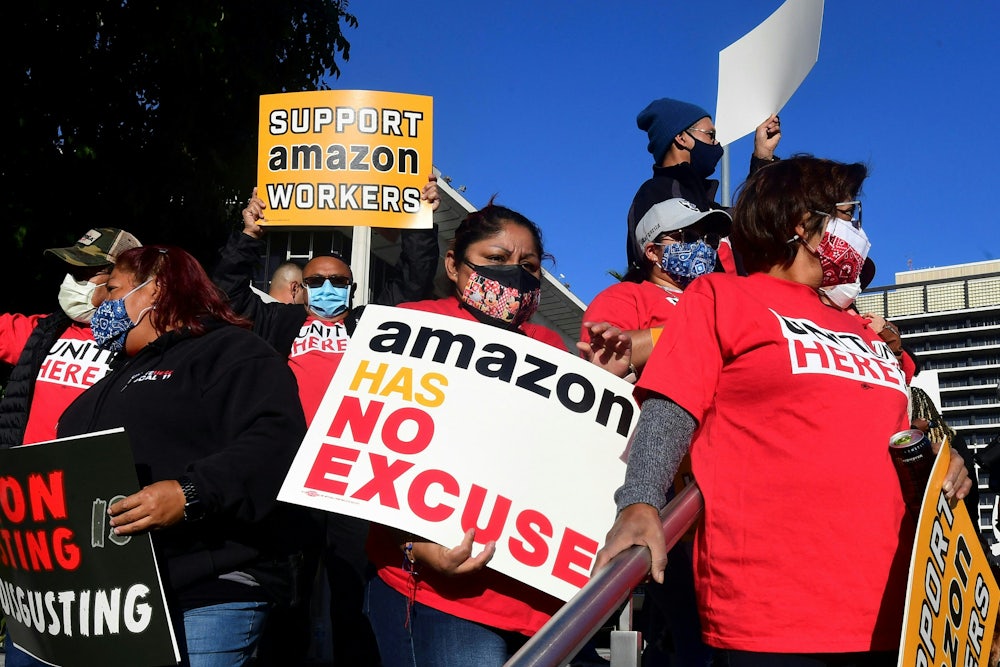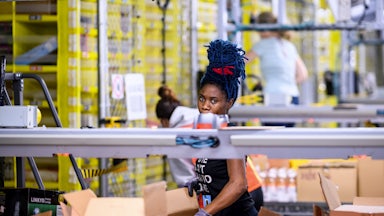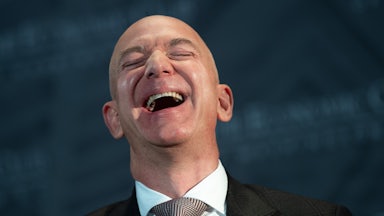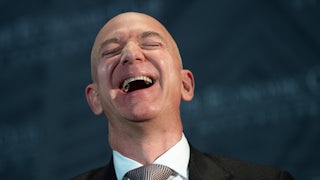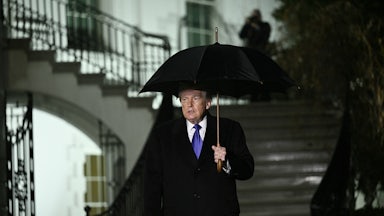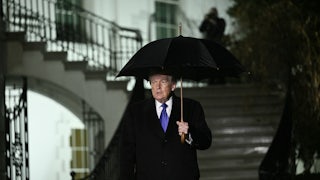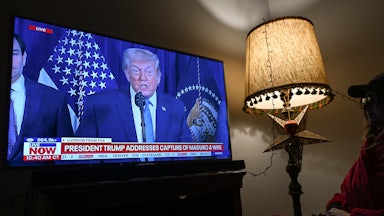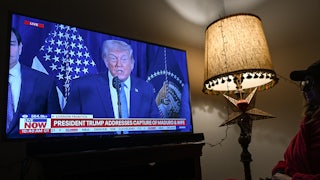The Amazon warehouse in Bessemer, Alabama, is 885,000 square feet of shiny new construction. Signs painted on the windows in bursts of green, red, yellow greet workers at the main entrance with the words: Work Hard. Have Fun. Make History. Under these slogans, the silhouette of Dr. Martin Luther King Jr.’s face adorns yellow placards reading, The Dream Is Alive.
Workers on break outside lean their elbows on their knees or pace around the entrance, the sleeves of their pants rolled up to their kneecaps in the hot sun. It is a March day, the usual balmy 74 degrees. People are too tired to talk shit and wait in silence to return to their shifts, staring at shadows on the pavement or eyeing their phone screens.
The facility, called BHM1, opened this time last year, just as the pandemic was bearing down on the United States. On March 29, as the company reported opening its doors to more than 1,500 full-time workers, the Covid-19 rate in Alabama had reached 827 confirmed cases, 250 of them in Jefferson County, where the warehouse sits. Elsewhere in the country, Amazon workers held sick-outs at Whole Foods, demanding hazard pay and benefits. Warehouse workers in Queens, led by Amazonians United, reported scrambling to stay on top of facility closures as a colleague tested positive and submitted their own petition demanding sick leave, hazard pay, and protocols around shutdowns in the event of positive cases. But in Bessemer, things were still new. “We’re proud to create great jobs in Bessemer, with industry-leading pay and benefits that start on day one, in a safe, innovative workplace,” Travis Maynard, Amazon’s director of operations, said in a statement marking the opening.
The shine wore off quick. “The dream is definitely not alive at Amazon,” Perry Connelly, a 58-year-old Amazon worker in Bessemer, told me this month. “We work for a billionaire, but we can’t live comfortable, not struggling to pay bills. Am I gonna buy groceries? Or am I gonna pay for my medicine?” The signs that greet him every shift feel like a smack in the face, he added: “A lot of us were going to go and take them down.”
Connelly is one of nearly 6,000 Amazon workers, the majority of whom are, like him, Black workers who have entered the final days of an election that will decide whether they’ll join the Retail, Wholesale and Department Store Union, or RWDSU. In February, over Amazon’s objections and failed attempt to force an in-person election during a pandemic, the National Labor Relations Board mailed ballots to Bessemer warehouse workers, who now have until March 29 to cast their votes.
No matter the outcome, the campaign in Bessemer has been freighted with historical significance for how it has twined together the civil rights history of its state; the urgency of the Black Lives Matter movement; and the struggle for a union to win respect, dignity, and better conditions on the job. The campaign represents the largest union push at Amazon in the country, and if the workers win, they will be the largest number of workers to certify a union in a single NLRB election in three decades. “They’re in a greenhouse,” Peter Olney, retired organizing director of the International Longshore and Warehouse Union, told me. “And we are all watching.”
The workers can feel it, too. Joshua Brewer, RWDSU’s lead organizer, said, “We had to make this big to succeed. Amazon would play their size against these workers.” To counteract Amazon’s messaging and union-busting tactics, Brewer said that the union had to create public accountability by putting a magnifying glass on the organizing drive.
The visibility of the campaign has attracted high-level support from Joe Biden to Stacey Abrams; it’s also raised a flag for other Amazon workers. In recent weeks, more than 1,000 workers have reached out to RWDSU seeking to organize their workplace. The campaign has galvanized workers in Baltimore, New Orleans, Portland, Denver, and Southern California to launch their own campaigns at Amazon facilities.
But these are tenuous, small first steps—at least relative to Amazon’s corporate gigantism, with 1.3 million workers worldwide. The RWDSU’s Brewer sees these overtures as encouraging signs but knows there’s a long fight ahead.
Last summer, against the backdrop of a nationwide wave of essential worker militancy, Darryl Richardson, an Amazon worker in Bessemer, reached out to RWDSU to talk about organizing a union. The fulfillment center had only been open a few months, but he already knew what he needed to about what it was like working there.
Richardson, in an interview earlier this month, told Sarah Jones at New York about the dismal conditions that spurred him to reach out to the union: chaotic scheduling that left him peering at his phone screen at odd hours of the night; working conditions so extreme that he said he had to stop taking bathroom breaks in order to meet productivity targets and avoid getting his take-home pay docked. It all took a toll. “Oh, you be sore. Your wrists be sore. Your legs be sore. You be cramping up. There really ain’t no way to stay comfortable because you’ve got to move when the robots move,” he explained.
This isn’t a unique experience. “Within the first week, I was ready to quit,” Connelly told me about his first days at Amazon. He started a few weeks after the facility opened. It hadn’t been his plan. He wanted a job at the Transportation Security Administration—a government job with good benefits. He had left his previous gig as a contractor for DirectTV shortly after the pandemic took hold, fearful of catching the virus in strangers’ homes where he set up equipment. He landed at Amazon because of a hiring freeze at the TSA.
Soon after, he started talking to organizers. We met “about three times, one-on-one,” Richardson said. Soon, five or six of his co-workers said they wanted to get involved, too. That early strategizing turned into a full-fledged campaign.
Days away from the final vote count, the town of Bessemer has the frenzied feeling of the last days of a presidential primary. Turf is marked across the state with yard signs planted in front of union supporters’ homes. People who oppose the union have door hangers on their rearview mirrors. Union organizers are dialing phones to remind people to return their ballots.
That community mobilization is a welcome respite from the air war Amazon unleashed, bombarding workers with anti-union messages, the latest iteration of the campaigns it has historically launched to defeat unions.
“A campaign against a union is an assault on individuals and a war on the truth. The only way to bust a union is to lie, distort, manipulate, threaten, and always attack,” Martin Jay Levitt, a former anti-union consultant, wrote in Confessions of a Union Buster, describing the sort of offensive anti-union companies like Amazon launch against workers.
Over the years, Amazon has made these tactics a core part of its strategy, expecting nothing but surrender from workers and brutal repression from managers. “If workers became anything less than docile, managers were told, it was a sign there could be union activity,” according to The New York Times. “Tipoffs included ‘hushed conversations’ and ‘small group huddles breaking up in silence on the approach of the supervisor,’ as well as increased complaints, growing aggressiveness and dawdling in the bathroom.”
The company has spread its anti-union messaging through a website, DoItWithoutDues.com, and a largely failed social media campaign. But the company line proliferated in other ways—in text messages, bathroom stalls, locker rooms, and mandatory, hours-long, captive-audience meetings with managers.
“Don’t stay on the sidelines,” read a representative February 14 text. “Vote now and vote ‘NO.’”
The company also used young contract workers recently released from prison as what one RWDSU organizer called “walking billboards” for Amazon’s union-busting efforts, pinning “vote no” buttons on their work vests. “You got these guys just getting out of being incarcerated, so it’s hard for them to find employment,” organizer Michael Foster told The American Prospect. “Amazon is preying upon their downfall.”
Amazon even reportedly changed the traffic lights outside the warehouse to prevent organizers from talking to workers at shift changes. Even after the voting in the union election began and labor law restrained Amazon from engaging in the most blatantly illegal union-busting tactics, the company installed a mailbox at the facility to monitor the vote-by-mail election, which is supposed to be anonymous.
The result of these intimidation and misinformation efforts has been a cloud of uncertainty. “I feel confused about it,” Amazon worker Sarah Scroggin told me. She voted against the union but now wants to change her vote. “Research” and “co-workers,” changed her mind, she told me, but it might be too late.
Part of that confusion might stem from the nature of the drive. In a typical union campaign, organizers can sometimes spend years mapping a workplace, identifying and educating leaders. Brewer told me that the tight timeline has “made [workers] more susceptible to the lies from the union-busters because they weren’t really rooted, like in a one-year or two-year campaign.”
RWDSU filed its election petition last November with the NLRB, after the call from Richardson in the late summer, followed by initial organizing meetings in September, and a public launch of the campaign in October. Before filing for an election, a union holds worker education sessions to prepare, an attempt to inoculate them against the boss’s tactics and build a sense of power and trust among workers in the campaign. Records of the NLRB reviewed by the Economic Policy Institute show that more than 40 percent of employers were charged with violating federal labor law in all union election campaigns during 2016 and 2017. Given the illegal tactics employers deploy to stymie worker organizing, unions put workers through what are called stress tests to assess their capacity to fight, hold strong against employer attacks, and win.
“Here you didn’t really have that opportunity,” Brewer added. “They were signing cards so fast. And knowing the turnover, we had to file [for a union election] pretty quickly because people were turning over as quickly as they were signing.” Whether or not the drive is conventional, he added, “at the end of the day, if workers want a union, we’re going to get them a union.”
Amazon, like other employers that have flocked to the South, has made the case for its tax breaks and subsidies on grounds that it would create good jobs. More than a quarter of residents in Bessemer live below the poverty line. The company’s spin has always been that it provides workers at Amazon with a total compensation and benefits package that outstrips anything offered by competitors, or even unions. (The company leans hard on this progressive rhetoric. Its consumer chief, Dave Clark, recently tweeted, “I often say we are the Bernie Sanders of employers, but that’s not quite right because we actually deliver a progressive workplace.”)
The median wage in greater Birmingham, which includes Bessemer, is $3 above the $15.50 base pay Amazon touts for warehouse workers at its facility, according to the Bureau of Labor Statistics. That hasn’t stopped Amazon from putting up a sign at the Bessemer warehouse calling on Congress to increase the federal hourly minimum wage to $15 in a gambit to burnish its reputation as a responsible corporate citizen: “Congress: Please match Amazon’s $15/hour minimum wage!” Warehouses and poultry plants nearby also pay $20 for similar, unionized work.
“The union is needed,” a young Amazon worker told me. “The management ain’t got no respect for nobody. They trying to have you any kind of way, man.”
“They are overworking people and not paying them what they need to be paying them,” he added. “Since it’s the pandemic, I think that should at least be $17 to $18. We got to come out during the coronavirus.”
Amazon’s workforce disproportionally comprises people of color nationwide. These essential workers on the front lines of a lethal pandemic have produced Amazon’s $9.7 billion in profit. Amazon has shared virtually none of that wealth with workers: According to the Brookings Institute, “The company’s stock price has risen 82 percent” in the last year, “while founder Jeff Bezos has added $67.9 billion to his wealth—38 times the total hazard pay Amazon has paid its 1 million workers since March.”
Worker demands for dignity and higher pay have captured the public’s attention. Last week, the Senate Budget Committee, chaired by Senator Bernie Sanders, held a hearing on the “Income and Wealth Inequality Crisis in America” to focus attention on the unfolding battle in Alabama. (Bezos was invited but declined to participate.)
In response to a question from Sanders on wage stagnation, in reference to General Motors workers earning $45 adjusted for inflation and Amazon or Walmart workers earning $15 today, former Labor Secretary Robert Reich said, “It’s not that the GM worker was so much more brilliant or productive than the Walmart worker. The difference is the GM worker had a union behind him.”
Many of the organizers at Amazon are former auto plant workers. They know the difference in their bones. Richardson, the Amazon worker who first contacted RWDSU, has deep ties to unions that go back to the United Auto Workers in Detroit’s Chrysler plant.
In many ways, however, his involvement in the campaign attests to labor’s weakened power. In 2019, Richardson lost his job at Faurecia, a Mercedes-Benz and Nissan seat manufacturer in nearby Cottondale, and his pay went down from $23.50 hourly as a UAW Local 2083 union member to $15 an hour as a picker at Amazon. Recent attempts to reassert a foothold in the auto plants of the South have failed at Nissan in Mississippi, in 2017, and Volkswagen in Tennessee, in 2019, among other losses.
Just as auto plants have shifted production to avoid unions, Amazon has built into its supply chain redundancies so that it can simply shut down a fulfillment center to foil any organizing attempts. Couldn’t the same thing happen in Bessemer, Alabama? I asked Brewer. “Where do you run to?” he responded. “They fled to the South to take advantage of low-wage workers.”
Some people see a win at Amazon opening a new front in the battleground to organize auto plants, lifting the floor for all workers in the South.
That’s a message organizers hope will carry into the union election. Brewer sounds optimistic about the prospects of a win. “We’re seeing hundreds and hundreds of people that want to call in to other workers and take a leadership role.”
Connelly told me that workers have reached out, hyping the Bessemer workers up about what they’ve managed to achieve in so little time. He said they tell him, “We’ve been going through this for years. Y’all been doing it for less than a year, and y’all already taken action.”
But what happens next remains an open question. The workers will know soon enough what their efforts have built. But the people I talked to had a horizon that extended beyond the vote closing on Monday. This felt like a start, not an end. “We plan to work on continuing to organize the South,” Brewer told me. “It’s not just a hashtag for us. All things are definitely on the table.”
